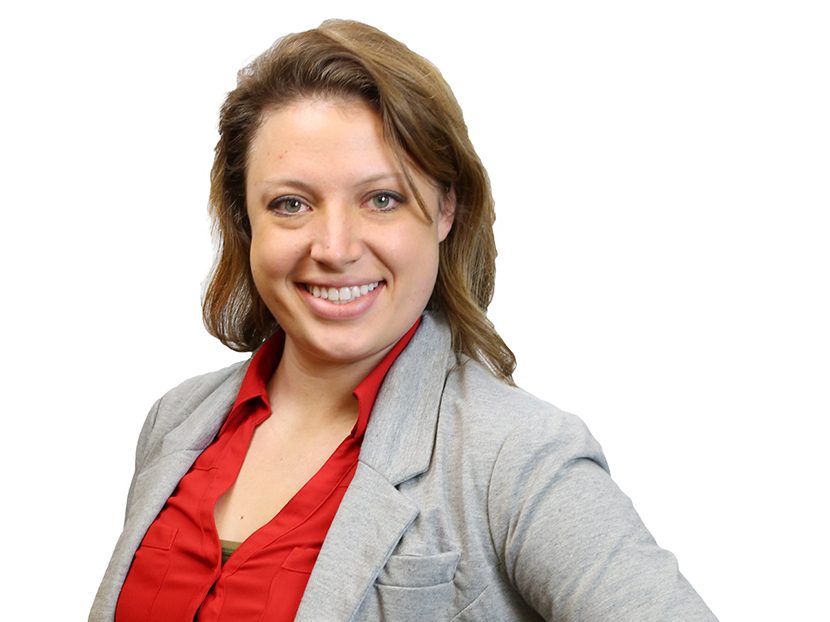Plumbing Engineer's Top 10 in Their 20s: Meagan Gibbs
Young engineers shine through commitment, perseverance and tenacity.

Originally from Omaha, Nebraska, Meagan Gibbs recently made the move to Kansas City, Kansas to take on the role of plumbing designer at Henderson Engineers.
A graduate of the University of Nebraska Lincoln, she received her bachelor’s degree in architectural engineering in 2014, and then her master’s degree in architectural engineering, with an emphasis in mechanical, in 2015.
Today, she specializes in plumbing design for Henderson’s health care clients where she calculates and designs whole plumbing systems for health care buildings, including sanitary and vent; domestic hot, cold, and recirculation; natural gas; storm and storm overflow; and medical gas equipment and distribution systems. “I enjoy designing complex spaces and buildings where people are cared for and their health and wellbeing is the upmost of importance,” Meagan says. “My favorite part of the day is helping clients and offering solutions to problems they are currently facing within their facilities. Specializing in health care plumbing design has offered me the opportunity to work on, and in facilities, that are very large, intricate, and inter-connected. Every day is interesting, challenging, and exciting!”
The journey
When she began in her career, she was responsible for many aspects of projects including plumbing design, HVAC design and piping design.
“I always felt myself drawn to the plumbing side,” she says. “I dove deep into the details of the fixtures and fixture selection, system design optimization, and system operation. This aligned perfectly since I was working on primarily health care projects. These intricate spaces require a high attention to detail to ensure the correct plumbing fixtures are incorporated and also the medical gas systems are correctly designed, sized, and laid out. The medical gas systems intrigued me! Medical gas is a complex system that directly supports life.”
Because of that intrigue, Meagan went on to attain her medical gas certification (ASSE 6005). In October of this year, she plans to sit for her PE license exam, and then follow that up with her CPD certification.
“Engineering is inspiring because of the challenges it solves and problems it answers,” she says. “Engineering as a whole is working together to create a better environment for everyone. With so many different aspects of engineering, I am looking forward to seeing all of the different perspectives and solutions that are proposed within the near future.”
The next steps
At such a young age, Meagan acknowledges she’s been lucky enough to be involved on a variety of health care projects. “There always seems to be a new piece of medical equipment coming out or a new way to perform a procedure that we need to design building systems to support,” she says. “I would like to continue to learn and be involved in these intricate and challenging projects.”
As far as what Meagan considers the biggest challenge facing the plumbing industry today, she points to the balancing act between energy efficiency, operations, and design wellness that designers and engineers must face.
“Engineering as a whole is hurdling down the road to become more energy efficient,” she says. “As new fixtures and pieces of equipment are introduced, plumbing designers must consider how they impact our existing systems, how to best include this new equipment in our designs, and how these new low flow fixtures will affect the building. Maintaining the balance between meeting the energy efficiency required by codes, keeping operations and the end use of a building at the forefront of the design, and ensuring the systems we design are promoting a healthy building design is a challenge!”
Paying it forward
Meagan hopes to continue to develop her plumbing and health care knowledge base and to mentor those around her with a desire to learn about plumbing engineering. “There is a shortage of plumbing designers,” she says, “so, fostering an interest in this part of our industry is important to me and crucial to continuing our growth as an engineering specialty.”
Meagan herself has had many great role models and mentors, so she understands the importance of connections and sharing knowledge. “Where I was aware of the importance of building and maintaining relationships with those whom you work with,” she says, “I have come to believe that the strength of your network is extremely important. The engineering industry is a tightknit group of individuals. The circle of individuals working within the engineering industry within health care is even more specialized. Individuals concentrating in plumbing within the health care circle are even fewer. The old adage is true to a point; it’s not what you know, but who you know. A solid foundation of experience, knowledge, and understanding is key. It is also crucial to work with those around you, reach out to your network, be mentored and mentor the next group of individuals joining the field.”
To anyone considering the engineering field, she says, “Find what drives you. Let what your passionate about direct your path. To those lucky few that are captivated by plumbing industry, go for it! Plumbing engineer is a rewarding industry that is only getting more and more complex. We need more young engineers excited to take on the future challenges and run with them!”
To those already in the field, she poses a question: “What do you think will be the next big “shift” in the plumbing industry?” Meagan already has her thoughts and is ready to get to work. We’re excited to see what comes of it!
Click here to read about the other Plumbing Engineer’s Top 10 in Their 20s.





